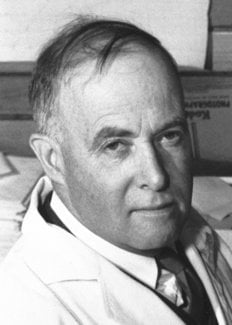James B. Sumner
Biographical

James Batcheller Sumner was born at Canton, Mass., on Nov. 19, 1887, as the son of Charles Sumner and Elizabeth Rand Kelly. His ancestors were Puritans who came from Bicester, England, in 1636 and settled in Boston. His father owned a large country estate, while his grandfather had a farm and also a cotton factory. Young Sumner attended the Eliot Grammar School for a few years and then was sent to Roxbury Latin school. At school he was bored by almost every subject except physics and chemistry. He was interested in fire-arms and often went hunting. While grouse hunting at the age of 17, he was accidentally shot in the left arm by a companion; as a consequence, his arm had to be amputated just below the elbow. Having been left-handed, he then had to learn to do things with his right hand. The loss of his arm made him exert every effort to excel in all sorts of athletic sports, such as tennis, skiing, skating, billiards, and clay-pigeon shooting.
In 1906 Sumner entered Harvard College; he graduated in 1910, having specialized in chemistry. After a short interval of working in the cotton knitting factory owned by his uncle, a type of work that did not interest him in the least, he accepted a teaching post at Mt. Allison College, Sackville, New Brunswick. This was followed by an assistantship in chemistry at Worcester Polytechnic Institute, Worcester, Mass., in 1911, from which he resigned in 1912 in order to study biochemistry with Professor Otto Folin at Harvard Medical School. Although Folin advised him to take up Law, since he thought that a one-armed man could never make a success of chemistry, Sumner persisted and obtained his Ph.D. degree in June, 1914. A few months later while travelling in Europe he was stranded in Switzerland for about a month by the outbreak of World War I. During this time he received a cable inviting him to be Assistant Professor of Biochemistry at Cornell Medical School, Ithaca, N.Y., a post which he held until 1929, when he was made full Professor of Biochemistry.
Sumner’s research work at Cornell first centered around analytical methods; despite hard work he was unable to obtain any interesting results. He then decided to isolate an enzyme in pure form, an ambitious aim never achieved by anyone up till then, but a type of research suited to his scanty apparatus and very small laboratory staff. In particular, he worked with urease.
For many years his work was unsuccessful, but in spite of discouragement from colleagues who doubted whether any enzyme could ever be isolated in pure form he continued. In 1921, when his research was still in its early stages, he had been granted an American-Belgian fellowship and decided to go to Brussels to work with Jean Effront, who had written several books on enzymes. The plan fell through, however, because Effront thought Sumner’s idea of isolating urease was ridiculous. Back in Ithaca, he resumed his work until finally, in 1926, he succeeded (“I went to the telephone and told my wife that I had crystallized the first enzyme”, he wrote in an autobiographical note). His isolation and crystallization of urease met with mixed response; it was ignored or disbelieved by most biochemists, but it brought him a full professorship in 1929.
Gradually, recognition came. In 1937, he was given a Guggenheim Fellowship; he went to Uppsala and worked in the laboratory of Professor The Svedberg for five months. He was awarded the Scheele Medal in Stockholm in the same year. When Northrop, of the Rockefeller Institute, obtained crystalline pepsin, and subsequently other enzymes, it became clear that Sumner had devised a general crystallization method for enzymes. The opponents gradually admitted Sumner’s and Northrop’s claims – Willstätter last of all – and the crowning recognition came in 1946 when the Nobel Prize was awarded to Sumner and Northrop. In 1948, Sumner was elected to the National Academy of Sciences (USA).
Sumner was married three times: in 1915 he married Bertha Louise Ricketts whom he later divorced. They had six children, one of whom died at an early age. In 1931 he married Agnes Paulina Lundkvist, and finally in 1943 Mary Morrison Beyer. He died of cancer on August 12, 1955.
This autobiography/biography was written at the time of the award and first published in the book series Les Prix Nobel. It was later edited and republished in Nobel Lectures. To cite this document, always state the source as shown above.
Nobel Prizes and laureates
Six prizes were awarded for achievements that have conferred the greatest benefit to humankind. The 12 laureates' work and discoveries range from proteins' structures and machine learning to fighting for a world free of nuclear weapons.
See them all presented here.
